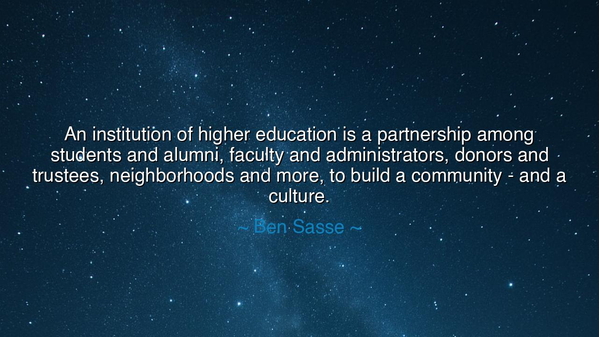
An institution of higher education is a partnership among
An institution of higher education is a partnership among students and alumni, faculty and administrators, donors and trustees, neighborhoods and more, to build a community - and a culture.






The statesman and scholar Ben Sasse once proclaimed: “An institution of higher education is a partnership among students and alumni, faculty and administrators, donors and trustees, neighborhoods and more, to build a community — and a culture.” These words are not the voice of bureaucracy, but of vision. Sasse, who has lived both as a university president and a public servant, reminds us that a college is far more than buildings of stone and glass — it is a living organism, a sacred gathering of people bound by a common purpose: the cultivation of knowledge, virtue, and belonging. His words reach beyond policy; they describe a covenant, a moral alliance between generations in pursuit of wisdom and the flourishing of civilization.
In the ancient world, such partnerships were seen as the foundation of society itself. The Academy of Plato in Athens was not merely a place where philosophy was taught — it was a fellowship of minds devoted to truth and the good. Teachers guided students, but students, too, refined teachers through questions and debate. Patrons and benefactors ensured that learning could survive beyond a single lifetime, and the city itself was enriched by the wisdom that flowed from those sacred groves. In the same spirit, Sasse reminds us that education is sustained only when all members of society share in its burden and its blessing — when learning becomes a shared trust, not a solitary possession.
When Sasse speaks of “a partnership among students and alumni, faculty and administrators, donors and trustees, neighborhoods and more,” he calls us to remember that no institution of higher learning exists in isolation. The university is a mirror of the world — its greatness or decay reflects the care or neglect of its people. Students bring curiosity and energy, professors bring insight and mentorship, administrators provide structure and stewardship, while alumni and donors ensure the torch is carried forward. Even the neighborhoods — the cities that cradle these halls of learning — are part of this grand enterprise, for education thrives only when it serves the common good.
History gives us vivid examples of this truth. Consider the rise of the University of Bologna in medieval Italy, the oldest university in the world. It was not founded by kings or decrees, but by a coalition of students and teachers who came together to protect and pursue learning. They forged agreements with the local community, gained support from patrons, and created a structure that endured for centuries. This partnership — between youth and elders, rich and poor, scholar and citizen — became the model for all modern universities. It proved that education is not the work of one class or generation, but of a united people dedicated to enlightenment.
Sasse’s vision also reminds us of the sacred responsibility that comes with such collaboration. When any one part of this partnership fails — when students grow apathetic, teachers lose passion, or trustees seek profit over purpose — the entire community suffers. A university, like a republic, can survive only through mutual respect and shared sacrifice. The culture it builds is not imposed from above, but grown from within — through dialogue, service, and the relentless pursuit of truth. It is in this balance that a campus becomes more than a school; it becomes a microcosm of a just and thoughtful society.
This quote also speaks to our age of fragmentation. In a world where knowledge is often commodified and education reduced to career training, Sasse calls us back to the ancient purpose of learning — to shape souls, not merely skills; to create citizens, not just employees. The “community” and “culture” he describes are not built through technology or prestige, but through relationships — through the meeting of minds and hearts, generation after generation. It is only when all the members of this partnership honor their roles that education fulfills its noblest mission: to illuminate the world and uplift humanity.
Thus, the lesson of Ben Sasse’s words is both timeless and urgent. Education must never be treated as a transaction — it is a covenant that binds individuals into a living community of wisdom. Each of us, whether student or teacher, parent or patron, shares in the duty to preserve and strengthen this bond. To support education is to sustain the light of civilization itself. Let us therefore cherish our schools and universities not merely as institutions, but as sacred gatherings of purpose — where knowledge is sown, character is forged, and culture is renewed for all generations.
For in the end, as Sasse so powerfully reminds us, a true institution of higher education is not built of stone, but of souls. It is a partnership of faith — faith in learning, in community, and in the enduring power of wisdom to shape a better world.






AAdministratorAdministrator
Welcome, honored guests. Please leave a comment, we will respond soon